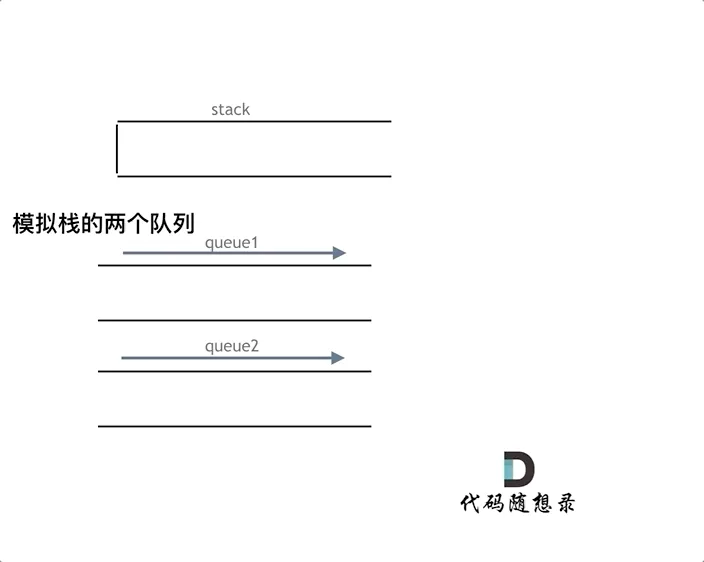Table of Contents
225. 用队列实现栈
简单
请你仅使用两个队列实现一个后入先出(LIFO)的栈,并支持普通栈的全部四种操作(
push、top、pop和empty)。实现
MyStack类:
void push(int x)将元素 x 压入栈顶。
int pop()移除并返回栈顶元素。
int top()返回栈顶元素。
boolean empty()如果栈是空的,返回true;否则,返回false。注意:
你只能使用队列的标准操作 —— 也就是
push to back、peek/pop from front、size和is empty这些操作。你所使用的语言也许不支持队列。 你可以使用 list (列表)或者 deque(双端队列)来模拟一个队列 , 只要是标准的队列操作即可。
示例:
提示:
1 <= x <= 9最多调用
100次push、pop、top和empty每次调用
pop和top都保证栈不为空**进阶:**你能否仅用一个队列来实现栈。
其实感觉用1个队列实现栈,比用2个队列更简单一点。
用2个队列实现栈
push: 把元素加到 queue1 中
pop/top:用 MoveWithoutLast() 将 queue1 中除最后一个外所有元素移入 queue2 ,就可以单独对栈顶元素操作了。pop: 返回栈顶元素并删除它;top: 返回栈顶元素,并将其加入 queue2 。最后 queue1 为空,queue2 包含所有元素,交换 queue1 和 queue2
empty: 判断 queue1 和 queue2 是否同时为空
动画演示:
模拟的队列执行语句如下:
queue.push(1);queue.push(2);queue.pop(); // 注意弹出的操作queue.push(3);queue.push(4);queue.pop(); // 注意弹出的操作queue.pop();queue.pop();queue.empty();
完整代码:
type MyStack struct { // 2个队列 queue1 []int queue2 []int}
func Constructor() MyStack { return MyStack { queue1: []int{}, queue2: []int{}, }}
func (s *MyStack) Push(x int) { s.queue1 = append(s.queue1, x)}
func (s *MyStack) Pop() int { s.MoveWithoutLast() val := s.queue1[0] s.queue1 = s.queue1[1:] // 去除第一个元素,即变成空切片 s.queue1, s.queue2 = s.queue2, s.queue1 // 交换,把 queue1 置为 queue2, queue2 置为空 return val}
func (s *MyStack) Top() int { s.MoveWithoutLast() val := s.queue1[0] s.queue2 = append(s.queue2, val) s.queue1 = s.queue1[1:] // 去除第一个元素,即变成空切片 s.queue1, s.queue2 = s.queue2, s.queue1 // 交换,把 queue1 置为 queue2, queue2 置为空 return val}
func (s *MyStack) Empty() bool { return len(s.queue1) == 0 && len(s.queue2) == 0}
func (s *MyStack) MoveWithoutLast() { // 除 queue1 最后一个元素,其余元素转移至 queue2 for i := 0; i < len(s.queue1) - 1; i++ { s.queue2 = append(s.queue2, s.queue1[i]) } // queue1 中只保留最后一个元素 s.queue1 = s.queue1[len(s.queue1)-1:]}
/** * Your MyStack object will be instantiated and called as such: * obj := Constructor(); * obj.Push(x); * param_2 := obj.Pop(); * param_3 := obj.Top(); * param_4 := obj.Empty(); */用1个队列实现栈
push: 直接加到队列末尾
pop/top: 把除栈顶元素(最后一个元素)以外的所有元素,一个一个移到队列尾,就可以对栈顶元素操作了。pop: 读取并删除它;top: 读取并将其添加到 queue 末尾。
empty: 判断 queue 是否为空
可以用以下方法快速找到栈顶元素,并将其他元素放到 queue 末尾:
for range len(s.queue) - 1 { first := s.queue[0] // 把第一个元素移到queue末尾 s.queue = append(s.queue, first) s.queue = s.queue[1:] // 移除第一个元素 }完整代码:
type MyStack struct { queue []int}
func Constructor() MyStack { return MyStack { queue: []int{}, }}
func (s *MyStack) Push(x int) { s.queue = append(s.queue, x)}
func (s *MyStack) Pop() int { s.MoveWithoutLast() val := s.queue[0] s.queue = s.queue[1:] return val}
func (s *MyStack) Top() int { s.MoveWithoutLast() val := s.queue[0] s.queue = append(s.queue, val) s.queue = s.queue[1:] return val}
func (s *MyStack) Empty() bool { return len(s.queue) == 0}
func (s *MyStack) MoveWithoutLast() { for range len(s.queue) - 1 { first := s.queue[0] // 把第一个元素移到queue末尾 s.queue = append(s.queue, first) s.queue = s.queue[1:] }}
/** * Your MyStack object will be instantiated and called as such: * obj := Constructor(); * obj.Push(x); * param_2 := obj.Pop(); * param_3 := obj.Top(); * param_4 := obj.Empty(); */